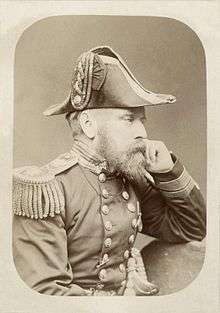John Moresby
| John Moresby | |
|---|---|
 | |
| Born |
15 March 1830 Allerford, Somerset, England |
| Died |
12 July 1922 (aged 92) Fareham, Hampshire, England |
| Allegiance |
|
| Service/branch |
|
| Rank | Rear Admiral |
| Commands held | HMS Endymion |
Rear Admiral John Moresby (15 March 1830 – 12 July 1922) was a British Naval Officer who explored the coast of New Guinea and was the first European to discover the site of Port Moresby.
Moresby was born in Allerford, Somerset, England, the son of Admiral Sir Fairfax Moresby.[1] He joined the Navy at an early age as a Volunteer 1st Class in HMS Victor, and rose to be in charge of the 1,031 ton paddle steamer cruiser HMS Basilisk in which he made hydrological surveys around eastern New Guinea.[2] During the survey of the southern coast he discovered the harbour which he named Fairfax after his father. The town established there, based on already existing native villages (principally Hanuabada) was named Port Moresby and is now the nation's capital.[3]
John Moresby was also searching for a shorter route between Australia and China and on the eastern tip of the island he discovered the China Straits. He continued exploring along the north west coast as far as the Huon Gulf.
On 29 September 1876, Moresby took command of HMS Endymion, remaining in this position until 6 March 1878.[4]
He was later promoted to Rear Admiral and died on 12 July 1922 in Fareham, Hampshire, England.[1]
Family
In 1859 he married Jane Willis Scott ( - 1876) of Queenstown, Ireland and had six children:
- Walter Halliday Moresby CBE (9 November 1861 – 24 April 1951), lawyer and spy
- Elizabeth Louisa Moresby (1862–1931) became a well-known writer under a variety of pseudonyms
- Ethel Fortescue Moresby (1865 - ?), married Frederick Haines
- Georgina Moresby (23 July 1867 - ?), married Peyton Temple Mackeson
- Hilda Fairfax Moresby (16 December 1868 – 16 August 1893), accidentally drowned
- Gladys Moresby (5 April 1870 - ?)
Works
- New Guinea and Polynesia..., John Moresby, John Murray 1876 (reprinted 2002, Elibron Classics, ISBN 1-4021-8798-X)
- Two Admirals, Admiral of the Fleet, Sir Fairfax Moresby (1786-1877), and His Son, John Moresby. A Record of Life and Service in the British Navy for a Hundred Years, John Moresby, Murray, London 1909
Notes and references
- 1 2 Beale, Howard. "Moresby, John (1830–1922)". Australian Dictionary of Bibliography. Australian National University. Retrieved 22 August 2011.
- ↑ "Torres Strait Island Shipwrecks". Encyclopedia of Australian Shipwrecks. Retrieved 22 August 2011.
- ↑ "ISS Port Moresby". In chcape Shipping Services. Retrieved 22 August 2011.
- ↑ "Endymion". Peter Davis. Retrieved 22 July 2011.